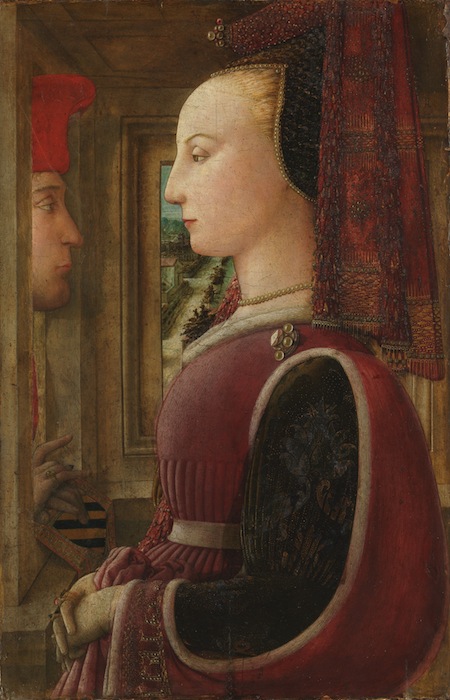 This painting by Fra Filippo Lippi (1406-1469) reminds me a bit of Romeo and Juliet. The young man has climbed up to the window of his favorite lady and is trying to convince her to accept his favors; in this case, his family crest. Could it be a betrothal?
This painting by Fra Filippo Lippi (1406-1469) reminds me a bit of Romeo and Juliet. The young man has climbed up to the window of his favorite lady and is trying to convince her to accept his favors; in this case, his family crest. Could it be a betrothal?
Well, according to historians, my bit of romantic fantasy just doesn’t fit the reality of this famous Italian Renaissance painting, though I was not entirely off the mark.
First off, one of the garments worn by the lady indicates that she is in fact a newlywed. She is wearing a Sella alla fiamminga. It is the lavishly beaded headdress she is wearing and when combined with the jewelry she is wearing, it would indicate that she is a newly wed woman. Historians suspect she is Angiola di Bernardo Sapiti and that her groom is Ranieri Scolari. The pair wed in 1436.
The head-dress was designed to emphasize her high forehead, which was considered a mark of elegance and beauty during the Renaissance. In fact, some women would pluck their hair along their hairline to make their forehead even taller.
This painting is considered important because it was done before couples regularly used portraits to commemorate their betrothals, weddings or the birth of children. It may be the first such painting in existance. Before this work, portraits of the wealthy were generally done by incorporating their likeness into a historical or Biblical work.
Additionally, such portraits were not of the couple together as this one is. The date, generally accepted as the completion of this painting, is four years after their marriage. While she has her hands across her stomach, as if pregnant, it would be four years before the birth of their first child. Who knows, perhaps it commemorates the impending birth of a child who did not survive or was one of the first paintings to commemorate their wedding.
It’s hard to see but there’s a word embroidered in pearls on the fabric which drapes across her wrist…lealtà, which means loyalty.
One historian has, what I think might be the best explanation of this painting. As many marriages were arranged by the parents, the bride and groom often had never met before their wedding day. This portrait may have been commissioned by one of the families to let the husband to be see what his future bride looked like. The couple was married in 1436 and early dates for this painting do make it work for that timeline.
To me, there’s something superior and almost stoic about the woman. She is on the inside looking out at the groom. Her flawless, pale skin draws all eyes to her and epitomizes the ideal beautiful woman of the Italian Renaissance.
Learn more about this famous Italian Renaissance painter and his colorful life in our Biography of Fra Filippo Lippi.